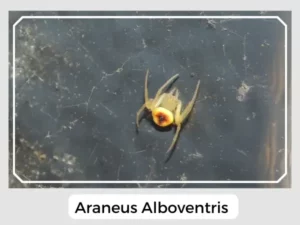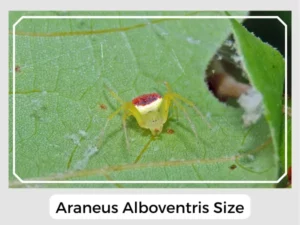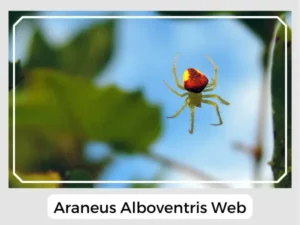Meet the Araneus alboventris, a unique spider from the orb weaver family. These spiders are most commonly spotted in the month of July. We’ve gathered some interesting facts about them right here!

Photo Credit: Scotty Astro

Photo Credit: Bonnie Ott
The eggs are securely laid within a silk sac, a common practice for the safety and development of spider offspring.
Upon hatching, the spiderlings closely resemble the adults in both color and form.
True to their family, Araneus alboventris spiders construct circular, wheel-shaped webs which serve as both their hunting ground and home.

Photo Credit: Bonnie Ott
Yes, Araneus alboventris spiders are venomous, like most orb weaver spiders. Their venom helps them immobilize prey.
While Araneus alboventris spiders can bite, they usually don’t bite humans unless threatened. Their bite is mild and not deadly to humans.
Araneus alboventris plays a vital role in controlling insect populations. Their webs are not just architectural marvels but also effective traps for various flying insects, aiding in maintaining ecological balance.
Natural Predator: Birds and larger insects are among the natural predators of Araneus alboventris spiders, helping to keep their population in check within their natural habitat.
Prey-Predator Dynamics: The presence of Araneus alboventris in an ecosystem serves as a critical control for insect populations. Meanwhile, as prey, they support the dietary needs of their predators, highlighting their essential role in the food web.
Relationship with Humans: The interaction between Araneus alboventris spiders and humans is minimal. While they possess venom, it is not harmful to humans, and bites are uncommon, generally occurring only when the spider feels directly threatened.
| Lifespan | Around 1 year |
| Distribution | The United States |
| Habitat | Shrubbery |
| Diet | Insects |
In summary, the Araneus alboventris spider is a beneficial organism within its environment, serving as both a predator and prey.
Meet the Araneus alboventris, a unique spider from the orb weaver family. These spiders are most commonly spotted in the month of July. We’ve gathered some interesting facts about them right here!

Photo Credit: Scotty Astro

Photo Credit: Bonnie Ott
The eggs are securely laid within a silk sac, a common practice for the safety and development of spider offspring.
Upon hatching, the spiderlings closely resemble the adults in both color and form.
True to their family, Araneus alboventris spiders construct circular, wheel-shaped webs which serve as both their hunting ground and home.

Photo Credit: Bonnie Ott
Yes, Araneus alboventris spiders are venomous, like most orb weaver spiders. Their venom helps them immobilize prey.
While Araneus alboventris spiders can bite, they usually don’t bite humans unless threatened. Their bite is mild and not deadly to humans.
Araneus alboventris plays a vital role in controlling insect populations. Their webs are not just architectural marvels but also effective traps for various flying insects, aiding in maintaining ecological balance.
Natural Predator: Birds and larger insects are among the natural predators of Araneus alboventris spiders, helping to keep their population in check within their natural habitat.
Prey-Predator Dynamics: The presence of Araneus alboventris in an ecosystem serves as a critical control for insect populations. Meanwhile, as prey, they support the dietary needs of their predators, highlighting their essential role in the food web.
Relationship with Humans: The interaction between Araneus alboventris spiders and humans is minimal. While they possess venom, it is not harmful to humans, and bites are uncommon, generally occurring only when the spider feels directly threatened.
| Lifespan | Around 1 year |
| Distribution | The United States |
| Habitat | Shrubbery |
| Diet | Insects |
In summary, the Araneus alboventris spider is a beneficial organism within its environment, serving as both a predator and prey.